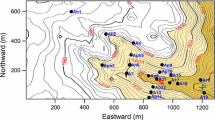Abstract
Transport by extremely weak turbulence occurring on nights with clear skies and weak winds is examined from seven tower levels of eddy-correlation data taken from each of two field programs. The very small flux is systematic, provided that the perturbations are computed from a record-dependent averaging length, which must be as small as 10 s in very stable conditions. With traditional methods for computing the flux, these fluxes were considered too small to estimate, in that the computed values behaved erratically. For extremely weak turbulence, the fluxes decrease systematically with height and often indicate very shallow boundary-layer depths on the order of 10 m. However, in one field program, the turbulence slowly increases with height above the surface flux-based boundary layer apparently due to horizontal advection of stronger turbulence driven by modest surface heterogeneity. For very weak turbulence, the eddy diffusivity for momentum is systematically greater than that for heat in both field programs. The dependence of the turbulence strength and its variability with stability is examined in some detail.
Similar content being viewed by others
References
Banta R.M., Newsom R.K., Lundquist J.K., Pichugina Y.L., Coulter R., Mahrt L. (2002). ‘Nocturnal Low-level Jet Characteristics over Kansas during CASES-99’. Boundary-Layer Meteorol. 105, 221-252
Banta R.M., Pichugina Y.L., Newsom R.K. (2003). ‘Relationship Between Low-Level Jet Properties and Turbulence Kinetic Energy in the Nocturnal Stable Boundary Layer’. J. Atmos. Sci. 60, 2549-2555
Cava D., Giostra U., Siqueira M., Katul G. (2004). ‘Organized Motion and Radiative Perturbations in the Nocturnal Canopy Sublayer Above an Even-Aged Pine Forest’. Boundary-Layer Meteorol. 112, 129-127
Coulter R., Doran J. (2002). ‘Spatial and Temporal Coverage of Intermittent Turbulence During CASES-99’. Boundary-Layer Meteorol. 105, 329-349
Cuxart J.C., Yagüe G., Morales E., Terradellas J., Orbe J., Calvo A., Fernndez M.R., Soler C., Infante P., Buenestado A., Espinalt H.E., Joergensen J.M., Rees J., Vilá J.M., Redondo I.L., Conangla I.R. (2000). ‘Stable Atmospheric Boundary-Layer Experiment in Spain (SABLE 98): A report’. Boundary-Layer Meteorol. 96, 337-370
Friehe C.A., Shaw W.J., Rogers D.P., Davidson K.L., Large W.G., Stage S.A., Crescenti G.H., Khalsa S.J.S., Greenhut G.K., Li F. (1991). ‘Air-Sea Fluxes and Sur- face-Layer Turbulence Around a Sea Surface Temperature Front’. J. Geophys. Res. 96, 8593-8609
Garratt J.R. (1990). ‘The Internal Boundary Layer-aReview’. Boundary-Layer Meteorol 50, 171-203
Ha K.-J., Mahrt L. (2003). ‘Radiative and Turbulent Fluxes in the Nocturnal Boundary Layer’. Tellus 55A, 317-327
Howell J., Sun J. (1999). ‘Surface Layer Fluxes in Stable Conditions’. Boundary-Layer Meteorol. 90, 495-520
Katul G., Albertson J., Parlange M., Chu C.-R., Stricker H. (1994). ‘Conditional Sampling, Bursting and the Intermittent Structure of Sensible Heat Flux’. J. Geophys. Res. 99, 22869-22876
Kim J., Mahrt L. (1992). ‘Simple Formulation of Turbulent Mixing in the Stable Free Atmosphere and Nocturnal Boundary Layer’. Tellus 44A, 381-394
Mahrt L., Vickers D. (2002). ‘Contrasting Vertical Structures of Nocturnal Boundary Layers’. Boundary-Layer Meteorol. 105, 351-363
Mahrt L., Vickers D. (2003). ‘Formulation of Turbulent Fluxes in the Stable Boundary Layer’. J. Atmos. Sci. 60, 2538-2548
Mahrt L., Vickers D. (2005). ‘Boundary-Layer Adjustment Over Small-Scale Changes of Surface Heat Flux’. Boundary-Layer Meteorol. (To appear)
Moraes O.L.L., Acevedo O.C., Da Silva R., Magnago R., Siqueira A.C. (2004). ‘Nocturnal Surface-Layer Characteristics at the Bottom of a Valley’. Boundary-Layer Meteorol. 112, 159-177
Nakamura R., Mahrt L. (2005). ‘A Study of Intermittent Turbulence with CASES-99 Tower Measurements’. Boundary-Layer Meteorol. 114, 367-387
Poulos G., Blumen W., Fritts D., Lundquist J., Sun J., Burns S., Nappo C., Banta R., Newsom R., Cuxart J., Terradellas E., Balsley B., Jensen M. (2001). ‘CASES-99: A Comprehensive Investigation of the Stable Nocturnal Boundary Layer’. Bull. Amer Meteorol. Soc. 83, 555-581
Poulos G., Burns S. (2003). ‘An Evaluation of Bulk Ri-Based Surface Layer Flux Formulations for Stable and Very Stable Conditions with Intermittent Turbulence’. J. Atmos Sci. 60, 2523-2537
Sun J., Burns S., Delany A., Horst T., Oncley S., Lenschow D. (2003). ‘Heat Balance in Nocturnal Boundary Layers’. J. Appl. Meteorol. 42, 1649-1666
Sun J., coauthors. (2004): ‘Atmospheric Disturbances that Generate Intermittent Turbulence in Nocturnal Boundary Layers’. Boundary-Layer Meteorol. 110, 255-279
Van de Wiel B.J.H., Moene A., Hartogenesis G., De Bruin H.A.R., Holtslag A A.M. (2003). ‘Intermittent Turbulence in the Stable Boundary Layer Over Land. Part III: A Classification for Observations During CASES-99’. J. Atmos. Sci. 60, 2509-2522
Vickers D., Mahrt L. (1997). ‘Quality Control and Flux Sampling Problems for Tower and Aircraft Data’. J. Atmos. Oceanic Tech. 14, 512-526
Vickers D., Mahrt L. (2003). ‘The Cospectral Gap and Turbulent Flux Calculations’. J. Atmos. Oceanic Tech. 20, 660-672
Vickers, D. and Mahrt, L. (2006). ‘A Solution for Flux Contamination by Mesoscale Motions with Very Weak Turbulence’. Boundary-Layer Meteorol. (in press)
Author information
Authors and Affiliations
Corresponding author
Rights and permissions
About this article
Cite this article
Mahrt, L., Vickers, D. Extremely Weak Mixing in Stable Conditions. Boundary-Layer Meteorol 119, 19–39 (2006). https://doi.org/10.1007/s10546-005-9017-5
Received:
Published:
Issue Date:
DOI: https://doi.org/10.1007/s10546-005-9017-5




